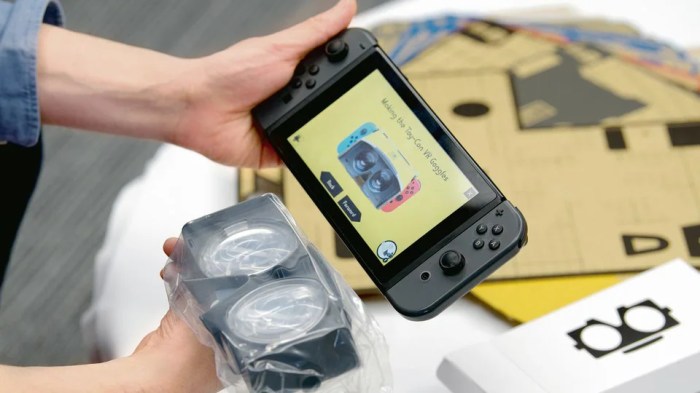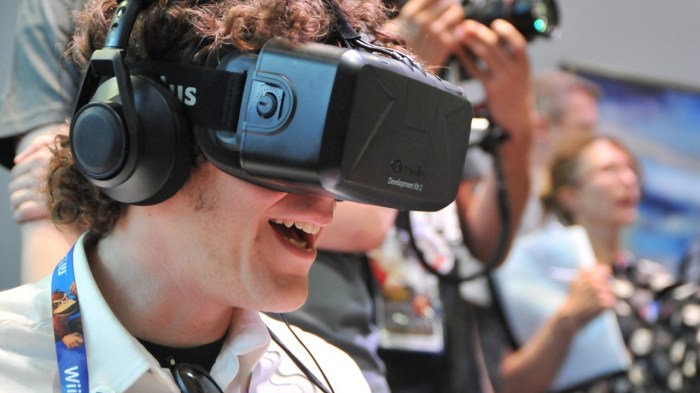Nintendo’s History with Virtual Reality: Nintendo Not Interested Virtual Reality
Nintendo’s relationship with virtual reality (VR) has been a curious one, marked by a single, notable foray into the technology and a subsequent avoidance of it despite its growing popularity. While the company has been a pioneer in innovative gaming experiences, its approach to VR has been decidedly different.
Nintendo’s First Attempt at VR
Nintendo’s first and only venture into the VR realm was the Virtual Boy, a handheld console released in 1995. This device, unlike its contemporaries, used a red-and-black 3D display, creating a unique but ultimately flawed experience. The Virtual Boy was plagued by several issues: its limited color palette, uncomfortable design, and a lack of compelling games contributed to its short lifespan and ultimately, its failure.
Reasons Behind the Virtual Boy’s Failure
The Virtual Boy’s failure can be attributed to a combination of factors.
- The red-and-black display was visually limiting and could cause eye strain, leading to a negative user experience.
- The console’s design was bulky and uncomfortable, especially for extended use.
- The limited game library lacked the variety and depth to attract a wide audience.
- The high price point, coupled with the limited appeal of the system, further hampered its success.
Nintendo’s Philosophy and Target Audience
Nintendo has historically focused on creating accessible and family-friendly gaming experiences, prioritizing fun and engagement over cutting-edge technology. Their core audience, often younger players, might not have been as receptive to the potentially isolating and immersive nature of VR. This, coupled with the lessons learned from the Virtual Boy, might have influenced their decision to avoid VR.
Nintendo’s Focus on Traditional Gaming
Nintendo has consistently stood out in the gaming world by prioritizing traditional gaming experiences, particularly with their consoles. While other companies have embraced virtual reality (VR) and its immersive potential, Nintendo has remained committed to offering engaging gameplay through familiar controllers and established game mechanics. This approach has resulted in a library of iconic franchises that have captured the hearts of gamers worldwide.
Traditional Gameplay and Iconic Franchises
Nintendo’s success can be attributed to its focus on delivering accessible and engaging gameplay. Many of their most popular franchises, like Mario, Zelda, and Pokémon, rely on traditional gameplay mechanics that have stood the test of time. These franchises offer a unique blend of simplicity and depth, making them appealing to a wide range of players.
- Super Mario Bros.: The iconic platforming series, known for its simple controls and challenging levels, has been a cornerstone of Nintendo’s success since the 80s. Players navigate Mario through various worlds, collecting coins and defeating enemies, using classic jumping and running mechanics.
- The Legend of Zelda: This beloved action-adventure series features a top-down perspective, challenging puzzles, and sword-based combat. The series encourages exploration, discovery, and strategic thinking, offering a rich and rewarding experience.
- Pokémon: The popular monster-catching franchise relies on turn-based combat and strategic team building. Players collect and train Pokémon, battling them against other trainers to become the ultimate champion.
Accessibility and Family-Friendly Experiences
Nintendo has always aimed to create games that are accessible to a wide audience, particularly families. Their consoles and games often feature intuitive controls and user-friendly interfaces, making them suitable for players of all ages and skill levels. This approach contrasts with VR, which can be more complex and require specialized equipment.
“Nintendo has always been about creating games that everyone can enjoy, regardless of their age or experience level. We believe in the power of games to bring people together, and we strive to make our experiences as accessible as possible.” – Shigeru Miyamoto, creator of Mario and Zelda
Nintendo’s commitment to accessibility and family-friendly experiences has been a major factor in its enduring popularity. While VR offers an exciting new frontier in gaming, Nintendo has chosen to focus on delivering engaging and accessible experiences through traditional gameplay and control mechanics. This approach has proven successful, solidifying Nintendo’s position as a leader in the gaming industry.
The Current VR Landscape
The virtual reality (VR) market has experienced significant growth in recent years, driven by technological advancements and the increasing popularity of immersive gaming experiences. However, despite the hype, VR adoption rates remain relatively low, and the technology faces several challenges that hinder its widespread appeal.
The VR Market: Popularity and Adoption Rates
While VR has garnered significant attention, its adoption rate has been slower than anticipated. According to Statista, global VR headset shipments reached approximately 11.2 million units in 2022, a considerable increase from previous years. However, this figure pales in comparison to the billions of smartphones and gaming consoles sold worldwide. The VR market is still in its early stages of development, and its mainstream adoption will depend on factors such as affordability, content availability, and user-friendliness.
Challenges and Limitations of VR Technology
VR technology faces several challenges that limit its widespread adoption. These include:
- High Cost: VR headsets and accompanying hardware, such as powerful computers, can be expensive, putting them out of reach for many consumers. The price barrier is a significant obstacle to mainstream adoption, particularly for those who are unsure about the value proposition of VR.
- Accessibility: VR headsets require a significant amount of space and can be uncomfortable to wear for extended periods. This can be a barrier for individuals with limited space or physical limitations. Additionally, the setup process can be complex, requiring technical knowledge and time investment.
- Content Availability: While the number of VR games and experiences is growing, the selection remains limited compared to traditional gaming platforms. The lack of compelling content can discourage potential users from investing in VR.
- Motion Sickness: Some users experience motion sickness when using VR headsets, particularly during fast-paced or intense experiences. This can be a major deterrent for individuals prone to motion sickness.
Nintendo’s Approach to VR Compared to Other Gaming Companies
Nintendo has taken a cautious approach to VR, choosing to focus on traditional gaming experiences rather than fully embracing the technology. This is in contrast to other major gaming companies like Sony and Microsoft, who have invested heavily in VR and released dedicated VR headsets. Sony’s PlayStation VR and Microsoft’s Windows Mixed Reality are examples of this commitment to VR.
Nintendo’s strategy is based on its belief that traditional gaming experiences, such as those offered by the Nintendo Switch, remain highly appealing to a wide audience. The company has explored VR through its “Labo” cardboard kits, which allow users to create their own VR experiences, but it has not released a dedicated VR headset.
Nintendo’s Future Plans
While Nintendo has historically been hesitant to embrace VR, the company is not entirely dismissing the technology. The future of VR is uncertain, but it’s possible that Nintendo could eventually find a way to incorporate VR elements into their games or even release dedicated VR experiences.
Potential Impact of VR on the Gaming Industry
VR has the potential to revolutionize the gaming industry by offering immersive and interactive experiences unlike anything seen before. The technology allows players to step into virtual worlds and interact with them in ways that were previously impossible. However, VR also presents challenges, such as the high cost of hardware, motion sickness, and the limited availability of compelling content.
Possible Scenarios for Nintendo’s Involvement in VR
Nintendo could choose to enter the VR market in several ways. One possibility is that they might develop specific VR experiences for their existing franchises, such as Mario Kart or Zelda. These experiences could offer players a unique and immersive way to interact with their favorite characters and worlds. Another possibility is that Nintendo might integrate VR elements into their existing games, allowing players to experience certain parts of the game in a virtual reality setting. For example, players could use VR to explore a specific location or participate in a particular gameplay segment.
The Potential Benefits and Drawbacks of Nintendo’s VR Involvement
Nintendo’s potential foray into the VR market presents a complex landscape of opportunities and challenges. While VR offers exciting avenues for innovation, it also carries risks that could impact Nintendo’s core identity and its relationship with its loyal fanbase.
The Potential Benefits of Nintendo’s VR Involvement, Nintendo not interested virtual reality
The potential benefits of Nintendo’s VR involvement are substantial. VR offers a unique opportunity for Nintendo to reach new audiences and explore innovative gameplay mechanics, further solidifying its position as a leader in the gaming industry.
- Reaching New Audiences: VR could attract a new generation of gamers who are drawn to immersive experiences. Nintendo’s family-friendly approach and emphasis on accessibility could translate well to VR, potentially attracting a wider demographic.
- Exploring Innovative Gameplay Mechanics: VR allows for entirely new ways to interact with games, providing opportunities for Nintendo to experiment with innovative gameplay mechanics. Imagine a Mario game where players physically jump over obstacles or a Zelda game where they can explore Hyrule with a sense of true presence.
- Strengthening Brand Image: Nintendo’s entry into VR could reinforce its image as a forward-thinking and innovative company. It could showcase their commitment to exploring new technologies and providing cutting-edge experiences for its players.
The Potential Drawbacks of Nintendo’s VR Involvement
While the potential benefits of Nintendo’s VR involvement are significant, it’s crucial to consider the potential drawbacks. Entering the VR market could compromise Nintendo’s core identity and potentially alienate its existing fanbase.
- Compromising Core Identity: Nintendo’s success has been built on its unique approach to gaming, focusing on family-friendly experiences and intuitive gameplay. VR could potentially alienate their traditional audience if it moves too far from this established identity.
- Alienating Existing Fanbase: Some of Nintendo’s most loyal fans might resist the shift to VR, preferring the familiar and accessible nature of their traditional games.
- High Development Costs: Developing high-quality VR games is costly, requiring specialized hardware and software. This could pose a significant financial risk for Nintendo, especially if VR adoption doesn’t meet expectations.
Hypothetical VR Game for a Popular Nintendo Franchise
Let’s imagine a VR game for the beloved franchise, *Super Mario*. This game could leverage Mario’s iconic world and characters while incorporating immersive VR elements.
A VR *Super Mario* game could allow players to physically jump over obstacles, collect coins, and navigate through levels in a truly immersive experience. Imagine shrinking down to Mario’s size and experiencing the world from his perspective. Players could even interact with characters like Luigi, Peach, and Bowser in a more engaging way.
This hypothetical game could leverage Mario’s strengths in level design and character interaction, while adapting them to a VR environment. It could be a platformer, a puzzle game, or even an adventure game, offering a unique and engaging VR experience.
Nintendo not interested virtual reality – While the VR landscape continues to evolve, Nintendo’s dedication to traditional gaming remains unwavering. Their decision to steer clear of VR, for now, is a testament to their commitment to their core values and the unique experiences they deliver. Whether they eventually embrace VR remains to be seen, but one thing is certain: Nintendo’s impact on the gaming world is undeniable, and their future will continue to be shaped by their unique vision and unwavering commitment to their core principles.
Nintendo’s decision to stay away from virtual reality might seem like a missed opportunity, but maybe they’re onto something. After all, look at what happened when Apple tried to shake things up with their plan for a cheap music streaming service – the music labels weren’t exactly thrilled. Maybe Nintendo’s focus on their own unique experiences is the smarter move, especially in a market where disruption can be met with resistance.
 Standi Techno News
Standi Techno News

